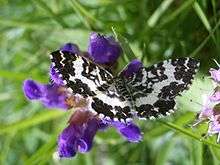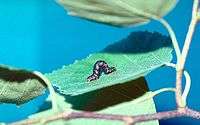Argent and sable
| Rheumaptera hastata | |
|---|---|
 | |
| Rheumaptera hastata (Julian Alps, Slovenia) | |
| Scientific classification | |
| Kingdom: | Animalia |
| Phylum: | Arthropoda |
| Class: | Insecta |
| Order: | Lepidoptera |
| Family: | Geometridae |
| Genus: | Rheumaptera |
| Species: | Rheumaptera hastata |
| Binomial name | |
| Rheumaptera hastata (Linnaeus, 1758) | |
Argent and sable moths or Rheumaptera hastata are day flying moths of the Geometridae family, with distinctive black and white colourings. They tend to live on wetlands and hillsides. The larvae spin together the leaves of their food plants (such as birch and bog myrtle) to form their cocoons. It was named argent and sable in 1778. Argent and sable refers to the heraldic color names for black and white. Their distribution is Holarctic.

Distribution
The species occurs in almost all parts of Europe. The distribution area stretches over the Northern Asia to the Russian Far East and large parts of China on to Japan. The species occurs in large parts of North America. Currently three subspecies are distinguished Rheumaptera hastata hastata, Rheumaptera hastata nigrescens and Rheumaptera hastata thulearia.
Description
The wings have a black ground colour with variable white pattern elements. A wider inner cross and a narrow basal cross line are typical. The dark midfield is traversed by white patches, which may be continuous. The outer cross line forms a wide white band, which usually has a row of black dots. In the black area of the margin is a wavy line broken into white stains, which forms an arrow - or spearhead-shaped element (hastata is Latin for spear-shaped). The fringes are black and white patched. The pattern of the hind wing is similar to the front wing. In some forms the black tone is reduced on a few black stains.
Variation
C. hastata is extremely variable and splits up into several local race the name-typical form, is large, with the median band strongly broken behind the middle, the postmedian white bands broad, the "hastate" white marks in the middle of the distal area well developed. -ab. laxata Krulik has the white areas still further widened, the postmedian band much broader than usual, the black median markings narrowed and broken, no black dots in the postmedian band. ab. demolita Prout is a more extreme form, the black median band only remaining as a small patch on the discocellulars and a small one at the hindmargin.
References
| Wikimedia Commons has media related to Rheumaptera hastata. |